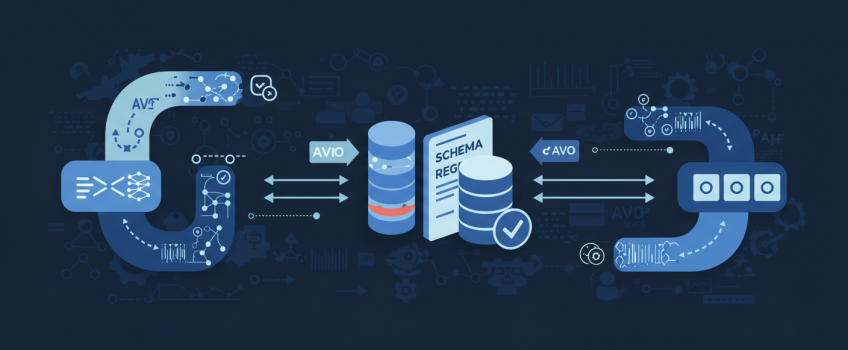The Importance of Schema Registry in Kafka

The Importance of Schema Registry in Kafka: Ensuring Data Quality and Evolution (with Avro/Protobuf)
In the dynamic world of microservices and evolving data requirements, maintaining data consistency and compatibility across your Apache Kafka topics can become a significant challenge. Producers might change data formats, breaking downstream consumers, or data quality can degrade due to inconsistent message structures. This is where a Schema Registry becomes an indispensable component of your Kafka ecosystem.
A Schema Registry provides a centralized repository for your message schemas (definitions of your data structure) and enforces compatibility rules, ensuring that data flowing through Kafka is well-defined, versioned, and consumable. When used with serialization formats like Apache Avro™ or Protobuf, it's a cornerstone for data governance, quality, and enabling the independent evolution of your data producers and consumers.
At ActiveWizards, we consistently advocate for and implement Schema Registry in our clients' Kafka deployments. This guide explores why it's crucial and how it works with popular formats like Avro and Protobuf.
The Chaos Without Schema Governance
Imagine a Kafka topic where producers send JSON messages. What happens if:
- Producer A renames a field?
- Producer B adds a new mandatory field?
- Producer C changes a field's data type (e.g., string to integer)?
Without schema enforcement, downstream consumers can break unexpectedly, leading to data processing failures, data loss, or the ingestion of corrupted data. Debugging these issues can be a nightmare, especially in complex, distributed systems.
Introducing Schema Registry: Your Data Contract Guardian
A Schema Registry acts as a centralized service for storing and retrieving your data schemas. Popular implementations include Confluent Schema Registry and Apicurio Registry.
Diagram 1: Role of Schema Registry with Kafka Producers and Consumers.
Its key functionalities include:
- Schema Storage: A versioned repository for schemas, typically identified by a subject (often related to a Kafka topic name).
- Schema Validation: Producers can validate their data against a registered schema before sending it to Kafka. Consumers can retrieve the schema to correctly deserialize incoming data.
- Compatibility Enforcement: This is the killer feature. Schema Registry can enforce rules about how schemas can evolve over time (e.g., backward, forward, or full compatibility). This prevents producers from making breaking changes that would impact existing consumers.
- Format Support: Commonly supports Avro, Protobuf, and JSON Schema.
Why Avro and Protobuf with Schema Registry?
While Schema Registry can work with JSON Schema, **Apache Avro** and **Protocol Buffers (Protobuf)** are often preferred for Kafka messages due to their:
- Strong Typing & Compactness: They offer compact binary serialization, reducing message size compared to JSON.
- Schema Evolution Capabilities: Both are designed with schema evolution in mind, defining clear rules for adding, removing, or modifying fields without breaking compatibility (when used correctly).
- Code Generation: Tools exist to generate typed data objects (POJOs in Java, case classes in Scala, etc.) from schemas, improving developer productivity and type safety.
Comparing Serialization Formats for Kafka with Schema Registry:
| Feature | Apache Avro | Protocol Buffers (Protobuf) | JSON Schema (with JSON data) |
|---|---|---|---|
| Schema Definition | JSON-based schema language. Schema often sent with data or by ID. | .proto definition files. Schemas compiled; not typically sent with data. |
JSON-based schema language. Schema validation. |
| Data Format | Compact binary. | Compact binary. | Human-readable JSON (text). |
| Schema Evolution | Excellent, well-defined rules (backward, forward, full compatibility). | Good; requires careful management of field numbers. Adding optional fields is easy. | Can be complex; relies on JSON Schema validation rules which can be verbose. |
| Performance (Serialization/Deserialization) | Very good. | Excellent, often considered fastest. | Slower due to text parsing. |
| Data Size | Small. | Very small. | Larger due to text format and field names. |
| Code Generation | Strong support across many languages. | Strong support across many languages. | Possible, but less mature/standardized than Avro/Protobuf. |
| Schema Registry Integration | Excellent, widely supported (e.g., Confluent Schema Registry). | Good support, also widely supported. | Supported, but schema evolution rules are registry-dependent. |
How Schema Registry Works: A Conceptual Flow
- Schema Definition: You define your data structure using Avro IDL, a
.protofile, or a JSON Schema file. - Schema Registration:
- Typically, the first producer instance wanting to write data for a new "subject" (e.g.,
my_topic-value) will register the schema with the Schema Registry. - The Schema Registry assigns a unique ID to this schema version.
- Typically, the first producer instance wanting to write data for a new "subject" (e.g.,
- Producer Serialization:
- When a producer sends a message, it serializes the data using the appropriate serializer (e.g.,
KafkaAvroSerializer). - The serializer communicates with the Schema Registry:
- If the schema is already registered, it gets the schema ID.
- If not (and auto-registration is enabled), it registers the schema and gets an ID.
- The serialized message sent to Kafka typically includes the schema ID (or a "magic byte" + ID for Avro). The full schema is *not* sent with every message.
- When a producer sends a message, it serializes the data using the appropriate serializer (e.g.,
- Consumer Deserialization:
- When a consumer reads a message, it uses the appropriate deserializer (e.g.,
KafkaAvroDeserializer). - The deserializer extracts the schema ID from the message.
- It queries the Schema Registry using this ID to fetch the *writer's schema* (the schema used by the producer to write that specific message).
- The deserializer then uses the writer's schema (and optionally, its own *reader's schema*) to deserialize the message into an object. This allows for safe schema evolution.
- When a consumer reads a message, it uses the appropriate deserializer (e.g.,
Pro-Tip: Configure your Schema Registry with a compatibility type (e.g., BACKWARD, FORWARD, FULL, BACKWARD_TRANSITIVE) appropriate for your evolution needs. BACKWARD compatibility (new schema can read old data) is a common default and allows consumers to upgrade before producers.
Configuring Kafka Clients to Use Schema Registry (Conceptual)
Here are conceptual examples of how you might configure Kafka producers and consumers in Java to use Confluent Schema Registry with Avro.
Producer Configuration (Java Properties):
Key Producer Properties for Schema Registry (Avro)
value.serializer=io.confluent.kafka.serializers.KafkaAvroSerializer
schema.registry.url=http://your-schema-registry-url:8081
auto.register.schemas=true (For development; consider false for production control)
key.serializer=org.apache.kafka.common.serialization.StringSerializer (If key is a simple string)
Consumer Configuration (Java Properties):
Key Consumer Properties for Schema Registry (Avro)
value.deserializer=io.confluent.kafka.serializers.KafkaAvroDeserializer
schema.registry.url=http://your-schema-registry-url:8081
specific.avro.reader=true (If using generated Avro specific record classes)
key.deserializer=org.apache.kafka.common.serialization.StringDeserializer
Best Practices for Using Schema Registry
- Choose the Right Serialization Format: Avro or Protobuf are generally recommended over plain JSON for Kafka due to efficiency and stronger evolution support.
- Define Clear Naming Conventions for Subjects: Typically
<topic_name>-keyand<topic_name>-value. - Set Appropriate Compatibility Levels: Understand
BACKWARD,FORWARD, andFULLcompatibility and choose based on your upgrade strategy.BACKWARD_TRANSITIVEis often a safe bet. - Version Your Schemas Thoughtfully: Make incremental, compatible changes. Avoid deleting fields that consumers might still rely on (unless using
FORWARDcompatibility and producers upgrade first). - Automate Schema Registration in CI/CD: For production, disable auto-registration by producers and manage schema registration as part of your deployment pipeline.
- Secure Your Schema Registry: Implement authentication and authorization if needed.
- Monitor Schema Registry Health: Ensure it's available and performing well.
- Educate Your Teams: Ensure all developers working with Kafka understand schema evolution rules and best practices.
Conclusion: A Foundation for Data Governance and Quality
A Schema Registry is not just an optional add-on; it's a critical component for any mature Apache Kafka deployment that values data quality, interoperability, and the ability to evolve systems independently. By enforcing data contracts and managing schema evolution, it prevents data chaos, reduces integration issues, and empowers teams to build more resilient and maintainable streaming applications with Avro or Protobuf.
While setting up and managing a Schema Registry adds an operational component, the long-term benefits in terms of data integrity, developer productivity, and system stability far outweigh the initial effort.
Further Exploration & Official Resources
To learn more about Schema Registry and related concepts:
- Confluent Schema Registry Documentation
- Apicurio Registry Documentation
- Apache Avro Specification
- Google Protocol Buffers Documentation
Need to Implement Robust Data Governance for Your Kafka Ecosystem?
ActiveWizards provides expert consulting and implementation services for Apache Kafka and Schema Registry. We can help you establish best practices for schema management, data quality, and ensure your streaming data pipelines are built for reliability and evolution.



Comments (0)
Add a new comment: